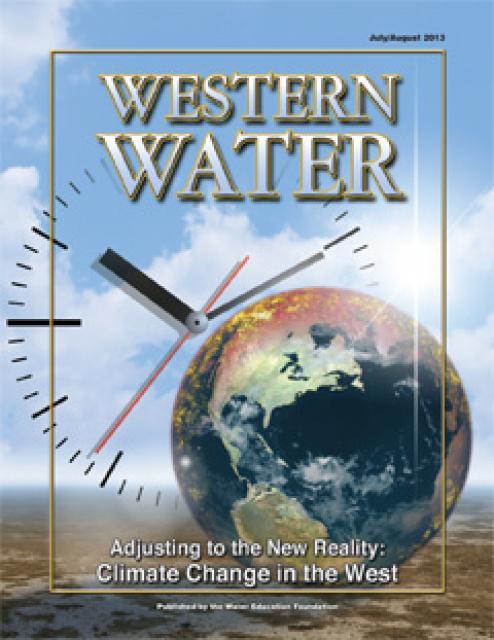Adjusting to the New Reality: Climate Change in the West
July/August 2013
Introduction
Like clockwork, the scientific studies describing climate change and its expected impacts keep coming, reminding everyone in an already-dry West of how much the future will differ from the past.
The dispatches from the scientific community echo a familiar refrain: rising temperatures, more rain in some areas, a reduced snowpack (and less water storage) and reduced imported water deliveries. The reports also reveal a level of uncertainty, something water managers in the West have learned to live with.
As Western Water went to press, the California Environmental Protection Agency unveiled a report describing decreasing spring snowmelt runoff, rising sea levels, shrinking glaciers, increasing wildfires, warming lakes and ocean waters, and the gradual migration of many plants and animals to higher elevations.
The report, Indicators of Climate Change in California, says “while no overall trend is discernible in statewide snow-water content (the amount of water stored in snowpack), a decreasing trend has been observed in the northern Sierra Nevada, and an increasing trend in the southern Sierra Nevada.”
Rich Atwater, the former general manager of the Inland Empire Utilities Agency who now serves as executive director of the Southern California Water Committee, said the findings reinforce the need for adaptability.
“I have worked with scientists [and] I respect their judgment,” he said. “They certainly indicate we can’t use our historic records like we have traditionally done in the water world when we do water resources planning.”
Water planning in the West has always been a challenge, with regular swings from wet periods to droughts. Factor in the effects of global climate change and ensuring a diversified water portfolio takes on another degree of complexity.
“The planning challenge that water utilities are facing is how do they modify their traditional planning framework to account for climate change, which is much more uncertain, and there’s not a lot of consensus about,” said David Groves, senior policy researcher with the RAND Corporation.
Groves, who has worked with major water utilities and the Department of Water Resources (DWR) in addressing climate change, said water managers should consider the range of plausible impacts “without worrying initially about how likely those impacts are, because we don’t have a lot of information about that, and it’s highly contentious.
“Once we understand our vulnerabilities and options for reducing them, the water community can then have an informed dialogue over likelihoods of the impacts and the tradeoffs in addressing them,” he said.
Adapting to warming temperatures and increased demand means ramping up water recycling and water conservation along with looking at pursuits such as desalination and importing water from other basins, which Groves acknowledged can be “very difficult and contentious projects.”
Planning for climate change means expecting dry times to happen, a practice ingrained in water agency planning. In Tulare County, the Kaweah Delta Water Conservation District has more than 40 recharge basins covering about 5,000 acres to capture floodwaters for storage, something that will be useful if more precipitation falls as rain instead of snow.
“Everything we have been doing to try and capture those floodwaters goes right along with the scenario for best managing a climate change situation,” said Mark Larsen, general manager for the district. “It gives us more encouragement to keep going in that same direction.”
Studies from an array of respected institutions all point to a warmer and drier West. Writing in The Sacramento Bee June 23, Roger Bales, director of the Sierra Nevada Research Institute at UC Merced, and senior researcher Norm Miller described a forthcoming hydrologic system unlike the pattern California has experienced in modern times.
“The shift from snow to rain in the Sierra Nevada, decreased snow cover area, coupled with longer growing seasons, are certain to result in more winter stream flow and less summer stream flow, impacting water deliveries during the growing season,” Bales and Miller wrote in “How Climate Change May Affect Californians,” a series of responses to Rep. Henry Waxman, D-Los Angeles. “This loss of snowpack storage will reduce water security for California.”
Researchers with California State University, Fullerton and the University of Southern California say the region faces “a perennial freshwater availability crisis.”
“Climate models predict a drying of the American Southwest, including Southern California, over the next century,” said Matthew Kirby, associate professor of geological sciences with CSU Fullerton and lead author of the paper “Latest Pleistocene to Holocene hydroclimates from Lake Elsinore, California,” in the Sept. 15 edition of the journal Quaternary Science Reviews.
The Colorado River is the primary water source for 35 million people in the U.S. and the Republic of Mexico. Studies based on different climate change scenarios say the river’s flow will decline by 2050, with the estimates ranging from less than 10 percent to 45 percent.
The different estimates “have led to a lot of frustration,” said Julie Vano, lead author of “Understanding Uncertainties in Future Colorado River Streamflow,” published in June in the Bulletin of the American Meteorological Society. “This paper,” she said, “puts all the studies in a single framework and identifies how they are connected.”
The paper says “despite indications of consensus of climate models regarding future drying, there is still considerable variability in future climate projections.” As an example, a recent study by the Bureau of Reclamation found that two-thirds of 112 future climate projections from a set of global climate models used by the Intergovernmental Panel on Climate Change show drying, while one-third show “no change or increases in Colorado River streamflow, a number which varies depending on the global climate models and emission scenarios used.”
Drought has plagued the Colorado River Basin for more than a decade. A wet year in 2011 helped restore the reservoirs but this year’s extremely dry conditions have given fears that a shortage declaration could come as soon as 2015.
In May, the U.S. Geological Survey (USGS) reported that about 20 percent of the Rocky Mountain snowpack has disappeared the past 30 years because of warmer spring temperatures, reversing a trend that saw alternating snowpacks in the northern and central and southern Rockies. Runoff from the winter snowpack in the Rockies accounts for 60 to 80 percent of the annual water supply for more than 70 million people living in the western U.S., and is influenced by factors such as the snowpack’s water content, known as snow water equivalent, and the timing of snowmelt, according to USGS.
“From 1980 on, warmer spring temperatures melted snowpack throughout the Rockies early, regardless of winter precipitation,” said USGS scientist Greg Pederson, lead author of Regional Patterns and Proximal Causes of the Recent Snowpack Decline in the Rocky Mountains. “The model in turn shows temperature as the major driving factor in snowpack declines over the past thirty years.”
Another snowfall study predicts a 42 percent reduction of the snowpack in the mountains surrounding Los Angeles by 2050. The June study, Mid- and End-of-Century Snowfall in the Los Angeles Region, used two modeling scenarios regarding greenhouse gas emissions: “business-as-usual” and “mitigation.” In the former scenario, snowfall sees a “dramatic further reduction” by the end of the century (42 percent, while the latter showed a “negligible further reduction” (31 percent) from mid-century.
“Climate change has become inevitable, and we’re going to lose a substantial amount of snow by mid-century,” said study author Alex Hall, professor with the University of California, Los Angeles’ Department of Atmospheric and Oceanic Sciences. “But our choices matter. By the end of the century, there will be stark differences in how much snowfall remains, depending on whether we begin to mitigate greenhouse gas emissions.”
The prospect of a reduced snowpack in Southern California is not as daunting as the loss in the larger watersheds upon which the region depends, Atwater said.
“If you are talking about the Colorado Rockies and the Colorado River and the Sierras, less snowpack and more rainfall is a big deal because if it’s not snowpack and it’s rain, it runs off in January, February and March instead of staying up in the mountains until April or May and it affects the flood control operations and the storage and the way we operate the reservoirs,” he said. “The amount of snow we get on Mount Baldy, the San Gabriels and Big Bear isn’t that significant and doesn’t affect the runoff that much.”
Meanwhile, a 120-author report prepared for the National Climate Assessment and spearheaded by the University of Arizona and several partner institutions, says there is “high confidence that the climate of the Southwest will continue to change through the 21st century and beyond in response to human-generated greenhouse gas emissions, and will continue to vary in ways that can be observed in historic and paleoclimate records.”
The report, Assessment of Climate Change in the Southwest United States, notes that “not all aspects of the climate change or variation can be projected with equal confidence,” but that the Southwest “has a long legacy of human adaptation to climate variability that has enabled society to live within environmental constraints and to support multiple-use management and conservation across large parts of the region.”
Indeed, the region has regularly known some stretches of dry conditions. Short-term droughts commonly occur in California, but only two droughts have lasted for more than four years in Northern California since record-keeping began in 1850. The first occurred between 1929 and 1934 and the second, 1987 to 1992, is considered the most severe drought in the state’s history.
The prospect of a reduced Sierra snowpack has prompted the Los Angeles Department of Water and Power (LADWP) to build the world’s largest groundwater treatment center to boost its local supply of drinking water. The utility plans to invest as much as $800 million to restore groundwater pumping of drinking water from San Fernando Valley wells that had been closed because of contamination.
“By 2035, we plan to reduce our purchases of imported water by half,” said James McDaniel, senior assistant general manager.
Then there is the potential impact of climate change on the state’s $43 billion agricultural industry. “Crops that are not water-efficient, such as rice and cotton, are very likely to be replaced with more water-efficient crops,” according to Bales and Miller. Many Central Valley specialty crops, “which are the foundation of the agricultural economy,” are especially vulnerable to higher nighttime temperatures, they said.
Shifting patterns of agricultural production in response to climate change “have received little attention as a potential impact pathway for ecosystems,” according to “Climate Change, Wine, and Conservation,” a report on wine production and climate change published in April in the Proceedings of the National Academy of Sciences.
Wine grape production provides a good test case for measuring indirect impacts mediated by changes in agriculture, “because viticulture is sensitive to climate and is concentrated in Mediterranean climate regions that are global biodiversity hotspots,” the report said.
Farmers have been traditionally resilient to weather extremes, but the advent of climate change puts an added emphasis on the need to augment the existing storage regime, said Chris Scheuring, managing counsel for natural resources and the environment with the California Farm Bureau Federation.
“Aside from the possibility of rising temperature, it seems to me the most important event we can plan forward on is changing hydrology,” he said. “Just to stay even in the terms of water supply in the context of climate change I think we have to think very seriously about some of these new surface storage projects.”
This issue of Western Water looks at climate change through the lens of some of the latest scientific research and responses from experts regarding mitigation and adaptation.
NOTE: Click here to purchase a copy of the entire article.
Editor’s Desk
The Evolution of Climate Change
Fifteen years ago the topic of climate change first was discussed in this magazine. At that time, I wrote that chief writer Sue McClurg and I recently had heard a number of intriguing presentations about climate change and it seemed to us as laypersons that the majority of scientists were beginning to agree that something about the climate was changing. They just couldn’t agree on what or exactly why.
From reviewing that 1998 magazine, I see now that the climate change debate was starting to heat up. Then there was genuine debate about a future in California in which droughts and floods could be more severe with warm rain, instead of snow, arriving at the wrong time and levees in the Delta being overcome by rising sea levels. Or, then again, maybe none of that would happen said many experts in the engineering and water community who were skeptical of what was termed “global warming.” But all agreed more flexibility in water management and planning was needed system wide.
We were interested enough in the topic to put on our first climate change conference a few years later in 2003. It was not successful – if you judged from the amount of people attending. In the fall of 2006 we again devoted an issue of Western Water to the topic titled, “An Inconvenient Future: Assessing the Impact of Climate Change.” The Department of Water Resources (DWR) recently had found growing evidence that water resources in California would be significantly affected by climate change and said so in the 2005 California Water Plan Update. In 2009 we worked with DWR to produce an exciting documentary, A Climate of Change. You can view part of that video in the digital version of this magazine.
Fast forward to this issue of Western Water and we see that now almost the entire scientific community is certain that climate change is real. The “why” part of the argument is no longer important and the reality of the existence of climate change is recognized. Now the planning challenge is upon us. As we learn in this magazine, adapting to warming temperatures and increased demand means turning to water recycling, conservation, ground and surface water storage and consideration of desalination as options. One thing is certain; we humans in the Southwest have long adapted to climate variations and have in the past lived with environmental challenges. Perhaps we can learn to manage our water to help us live with the very real fact of climate change.





